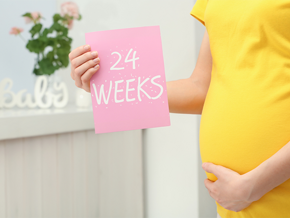
Things to Prepare Before Giving Birth: Your Complete Checklist
Maybe you've just finished a prenatal check-up, and the reality sinks in—your due date could be any day now! Your mind buzzes with all the things to prepare before giving birth. This checklist will guide you through every crucial step, from preparing your hospital essentials to getting your home ready for your little one so you can welcome your baby feeling calm, confident, and organized.
Preparing for Your Hospital Stay
Focusing on your hospital plan is important because babies don't always arrive on their estimated due date. Here are key things to prepare for delivery day:
1. Hospital bag checklist

Organize your hospital bag, important documents, and baby items before giving birth for a smoother experience.
Pack your bag between weeks 32 and 36 of your pregnancy. You don’t want to be scrambling when labor starts. To ensure you haven't missed anything and for a detailed breakdown with additional tips, check out this comprehensive mom-and-baby hospital bag checklist.
For you:
- Comfortable clothing (robe, nightgowns, pajamas)
- Going-home outfit (loose and comfortable)
- Toothbrush, toothpaste, shampoo, soap, deodorant, lip balm
- Maternity pads and comfortable underwear
- Nursing bra and breast pads
- Slippers and socks
- Phone and charger with a long cord
For your partner:
- A change of clothes
- Toiletries
- Snacks and drinks
- Wallet
- Phone charger
- Pillow and blanket
For baby:
- Tie-shirt or onesies
- Booties and mittens
- Bonnet
- Swaddle or blanket
- Newborn diapers and wipes
- Installed infant car seat for the ride home
2. Important documents to bring
Have a folder ready with all your paperwork. This can save you time during the admission process.
- Government-issued IDs for you and your partner
- Hospital admission forms if you pre-registered
- Health insurance card or PhilHealth documents
- Birth plan
- Prenatal records
3. Birth plan considerations
Your birth plan outlines your preferences for labor and delivery. A 2023 review published in Women and Birth found that it also allows you to feel more in control during childbirth. Since birth can be unpredictable, remember to stay flexible with your plan. Consider the following:
- Support person: Who do you want with you during labor and delivery?
- Pain management: Discuss options like epidural, breathing techniques, massage, and movement with your doctor.
- Atmosphere: Would you like soft lighting or soothing music (if your hospital allows it)?
- Delivery: This may include your preferences for movement and different positions during labor, as well as common interventions such as episiotomy.
- Post-delivery: Clarify your preferences if any. Every hospital performs immediate skin-to-skin contact or the Unang Yakap protocol.
Your doctor should sign off on your birth plan, and you shouldn't pursue one without their approval. Plus, check your birth plan against the policies of your preferred hospital or birthing center in advance. Public and private hospitals will have different rules about birth plan requests (some may not even accommodate them).
4. Arranging transportation to the hospital
To avoid getting frazzled on the big day, plan your transportation to the hospital or birthing center. Determine who’ll drive you, whether it’s your partner, a family member, or a trusted friend. Ensure you've installed the infant car seat as well.
For your backup plan, familiarize yourself with the quickest route to the hospital and at least one alternative. Keep a rideshare app on your phone, and save these numbers for urgent situations: 143 (Philippine Red Cross for ambulatory services), 911 (National Emergency Hotline), and your local barangay or municipal contacts for area-specific help.
5. Pre-registering at the hospital or birth center
Contact your chosen hospital or birthing center early, typically during your third trimester, and ask if they’ll allow you to pre-register for admission. Find out what required forms and payments need to be completed beforehand. This can save you time and stress, and ease some of your anxieties on the day.
Getting Your Mind and Body Ready Before Labor
Understanding what to prepare before giving birth ensures you’re mentally and physically ready in the last few months. Focus on those last health checks and familiarize yourself with the early signs of labor.
1. Final prenatal appointments and classes
Attend all your prenatal appointments, as your doctor will be monitoring you and your baby closely in the last few weeks. Use this time to discuss any lingering concerns you might have about your upcoming labor, delivery, or postpartum care.
Your third trimester is also a good time to take childbirth classes. You can learn about breathing tips, pain management strategies, and what to expect during labor.
2. Pre-labor signs to watch out for
Your body will also give you signs that labor is nearing. You might notice your baby dropping lower, feel practice contractions, or get a sudden urge to organize. Being aware of these signals is key to knowing when things are progressing and helps you feel ready for delivery. Discover more about the early signs of labor with this guide.
3. Mental preparation and rest
According to the World Health Organization (WHO), it's common for women to experience a wide range of emotions and mental shifts during pregnancy and after birth. To nurture your well-being, practice simple relaxation techniques, such as deep breathing exercises or mindfulness, or read about positive birth stories to build your confidence.
Remember to lean on your support system and discuss your feelings and expectations with your partner, close friends, or family. Prioritizing rest and getting as much sleep as possible in these final stages is also vital since you’ll need all your energy for labor.
Essential Gear, Supplies, and Nursery Setup for Baby

Limited space? You can use a bedside crib or bassinet that attaches securely to your bed.
Have your little one’s necessities prepared before their arrival. Getting all your baby needs before delivery can help ensure you focus on rest, recovery, and newborn care after the hospital.
1. Newborn essentials
When choosing comfortable clothing, make sure to prioritize light, presko fabrics like cotton or bamboo to help baby stay cool. You don't need everything at once, but make sure you have the basics, such as:
- Several onesies
- Sleepers
- Socks
- Bonnets
- Burp cloths—you’ll need plenty of these!
- A good stock of newborn-sized diapers
- Baby wipes
2. Baby sleep and care basics
Ensuring your newborn's safety and comfort, especially during sleep, is a top priority. Make sure to place your baby on their back for every sleep. With that in mind, here are some nursery and care items to consider:
- A crib, bassinet, or co-sleeper that meets current safety standards with a firm mattress and fitted sheet
- Swaddles or sleep sacks
- Baby bathtub
- Gentle baby soap or shampoo
- Soft towels
- Baby thermometer
- Nail clippers or a file
- Nasal aspirator
3. Setting up the nursery
You should have a calming space organized and ready for your little one, whether it’s a full nursery or a dedicated corner in your room.
You’ll need a changing table with a changing pad, diapers, wipes, and diaper cream within easy reach. Use drawers or bins to keep clothes and other supplies organized and accessible, especially during those late-night needs. Include a comfortable chair for feedings and cuddles!
If you're thinking of having your baby sleep with you on the bed, make sure your mattress is firm and flat. Check for any gaps that your little one could slip or sink into. Remove pillows, blankets, stuffed toys or anything else that could cause suffocation. You may want to consider sleeping on a floor bed, so you're less worried about your little one falling.
Planning Your Postpartum Journey
Keep in mind that creating a supportive environment for yourself and your growing family is also part of preparing for the arrival of a baby. Take time to discuss and outline your postnatal recovery plans with your partner or support network.
Consider how you’ll create moments for self-care and maintain your connection as a couple. You may also want to expand your support network by joining an online parenting community, such as the ParentTeam Moms and Dads Facebook group. It's a great way to connect with other parents and find support and information.
By taking these steps and organizing all the essential things to prepare before giving birth, you're now ready to welcome your new baby. This comprehensive preparation isn't just about checking items off a list; it’s about being better equipped for childbirth, recovery, and bonding with your little one.
References
Ahmadpour, P., S. Moosavi, and S. Mohammad-Alizadeh-Charandabi. "Effect of Implementing a Birth Plan on Maternal and Neonatal Outcomes: A Randomized Controlled Trial." BMC Pregnancy Childbirth 22, no. 862 (2022). https://doi.org/10.1186/s12884-022-05199-5.
Better Health Channel. "Overdue Babies." Accessed May 30, 2025. https://www.betterhealth.vic.gov.au/health/servicesandsupport/overdue-babies.
Institute for Quality and Efficiency in Health Care (IQWiG). "Birth: Learn More – When Your Baby’s Due Date Has Passed." In InformedHealth.org [Internet]. Cologne, Germany: IQWiG, 2006-. Last updated October 20, 2022. Accessed May 30, 2025. https://www.ncbi.nlm.nih.gov/books/NBK279571/.
National Library of Medicine. "What to Bring to Your Labor and Delivery." MedlinePlus. Last reviewed May 14, 2024. Accessed May 30, 2025. https://medlineplus.gov/ency/patientinstructions/000543.htm.
Northwestern Medicine. "10 Things to Do Before Going Into Labor." HealthBeat. Published August 2019. Accessed May 30, 2025. https://www.nm.org/healthbeat/healthy-tips/10-things-to-do-before-going-into-labor.
NHS (National Health Service). "Preparing for the Birth." Last reviewed January 10, 2024. Accessed May 30, 2025. https://www.nhs.uk/pregnancy/labour-and-birth/preparing-for-the-birth/.
NHS (National Health Service). "Pack Your Bag for Labour." Last reviewed January 10, 2024 (Media last reviewed February 2, 2023). Accessed May 30, 2025. https://www.nhs.uk/pregnancy/labour-and-birth/preparing-for-the-birth/pack-your-bag-for-labour/.
Philippine Statistics Authority. "Registered Live Births in the Philippines, 2023." PSA Site. Release Date December 20, 2024. Accessed May 30, 2025. https://psa.gov.ph/content/registered-live-births-philippines-2023.
PregnancyBirth&Baby. "Preparing Home for When Your Baby Arrives." Last reviewed March 2022. Accessed May 30, 2025. https://www.pregnancybirthbaby.org.au/what-you-will-need-for-baby.
The Mother Baby Center. "Third Trimester Checklist: Preparing to Welcome Your Baby." The Mother Baby Center (blog). September 30, 2022. Accessed May 30, 2025. https://www.themotherbabycenter.org/blog/2022/09/third-trimester-checklist/.




























